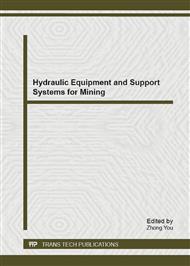p.3
p.9
p.14
p.18
p.22
p.26
p.30
p.34
p.39
Study on Mine Hoist Driven by PMSM of Low Voltage and Multi-Branch
Abstract:
As a set of typical mechanical and electrical integration equipment, mine hoist plays an important part in mineral mining industry known as the "mine throat". Traditional mine hoist mainly has the winding induction motor drive system, generator-dc machines and dc motor powered by the thyristor rectifier system. However, with the growing requirements of modern large mine hoist on hoisting tonnage, control performance, safety, reliability and the ratio of performance to price, the limitation of the traditional drive system emerges. If the permanent magnet synchronous motor(PMSM) is used to driven the heavy load, the speed reducer can be canceled. Thus, the performance of the system and control characteristic can be improved greatly. According to the status in this field above, this article brought forward a type of mine hoist with multi-rope friction driven by PMSM. A kind of multi branch control mode is adopted. Out of the actual needs of the project, a rated power 1300 kW of multi-rope friction mine hoist is designed and manufactured. Loss and heating of high power PMSM is studied. A kind of inner circulation air-cooled system is worked out. And good cooling effect is achieved.
Info:
Periodical:
Pages:
22-25
Citation:
Online since:
December 2012
Authors:
Keywords:
Price:
Сopyright:
© 2013 Trans Tech Publications Ltd. All Rights Reserved
Share:
Citation:


